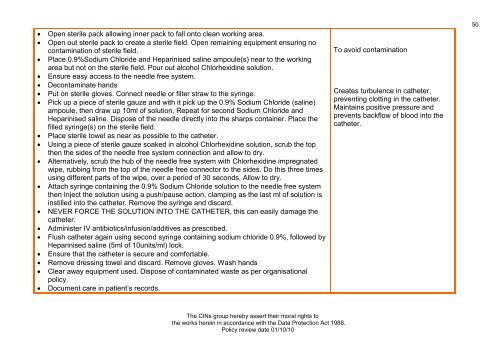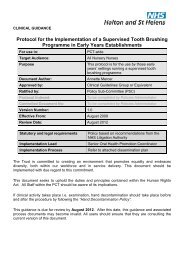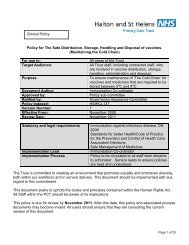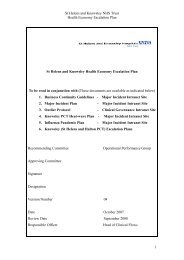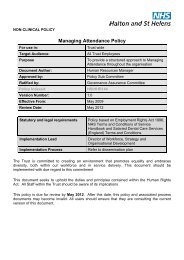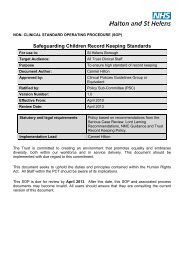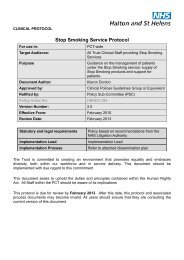Collaborative Intravenous Nursing Service (CINS) Guidelines
Collaborative Intravenous Nursing Service (CINS) Guidelines
Collaborative Intravenous Nursing Service (CINS) Guidelines
- No tags were found...
You also want an ePaper? Increase the reach of your titles
YUMPU automatically turns print PDFs into web optimized ePapers that Google loves.
• Open sterile pack allowing inner pack to fall onto clean working area.• Open out sterile pack to create a sterile field. Open remaining equipment ensuring nocontamination of sterile field.• Place 0.9%Sodium Chloride and Heparinised saline ampoule(s) near to the workingarea but not on the sterile field. Pour out alcohol Chlorhexidine solution.• Ensure easy access to the needle free system.• Decontaminate hands• Put on sterile gloves. Connect needle or filter straw to the syringe.• Pick up a piece of sterile gauze and with it pick up the 0.9% Sodium Chloride (saline)ampoule, then draw up 10ml of solution, Repeat for second Sodium Chloride andHeparinised saline. Dispose of the needle directly into the sharps container. Place thefilled syringe(s) on the sterile field.• Place sterile towel as near as possible to the catheter.• Using a piece of sterile gauze soaked in alcohol Chlorhexidine solution, scrub the topthen the sides of the needle free system connection and allow to dry.• Alternatively, scrub the hub of the needle free system with Chlorhexidine impregnatedwipe, rubbing from the top of the needle free connector to the sides. Do this three timesusing different parts of the wipe, over a period of 30 seconds. Allow to dry.• Attach syringe containing the 0.9% Sodium Chloride solution to the needle free systemthen Inject the solution using a push/pause action, clamping as the last ml of solution isinstilled into the catheter. Remove the syringe and discard.• NEVER FORCE THE SOLUTION INTO THE CATHETER, this can easily damage thecatheter.• Administer IV antibiotics/infusion/additives as prescribed.• Flush catheter again using second syringe containing sodium chloride 0.9%, followed byHeparinised saline (5ml of 10units/ml) lock.• Ensure that the catheter is secure and comfortable.• Remove dressing towel and discard. Remove gloves. Wash hands• Clear away equipment used. Dispose of contaminated waste as per organisationalpolicy.• Document care in patient’s records.To avoid contaminationCreates turbulence in catheter,preventing clotting in the catheter.Maintains positive pressure andprevents backflow of blood into thecatheter.50The CINs group hereby assert their moral rights tothe works herein in accordance with the Data Protection Act 1988.Policy review date 01/10/10


